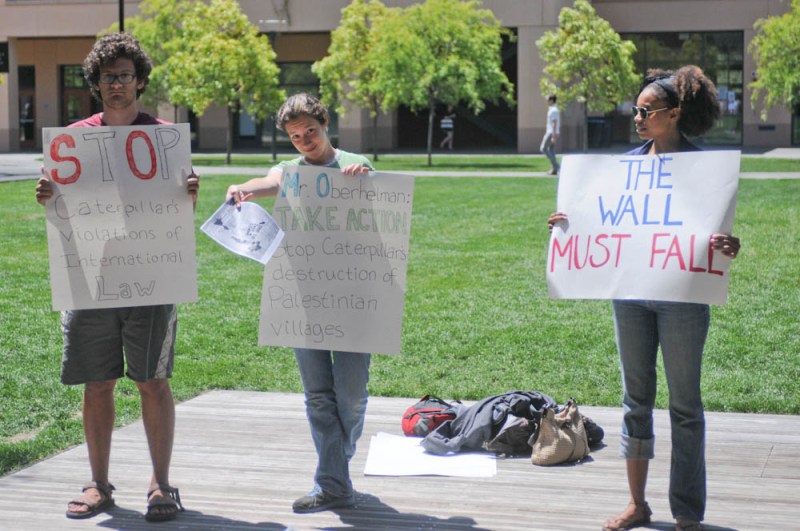Douglas Oberhelman, CEO and chairman of Caterpillar Inc., emphasized the long-term planning necessary to run his company in contrast with the start-up mindset of Silicon Valley in a speech Thursday night in Cemex Auditorium.

“We have to start planning now for the short, medium and long-term so we can be around for another 85 years,” Oberhelman said. “We have to deal with 10-year product cycles. Can you even imagine that happening over here?”
Outside the auditorium, a handful of students protested Oberhelman’s presence on campus and Caterpillar’s business practices in the Middle East.
While introducing Oberhelman, Graduate School of Business (GSB) Dean Garth Saloner credited Caterpillar Inc. — an 85-year-old company that is currently the world’s largest producer of construction and mining equipment, diesel and natural gas engines, and industrial gas turbines — with having its “fingers on the pulse of the world.”
“If you want to see where infrastructure development will fuel growth tomorrow,” Saloner said, “you should look at where Caterpillar is getting its orders today.”
During his talk, which was part of the GSB’s View From The Top speaker series, Oberhelman discussed the strategic value of working in emerging markets, commenting on the possibility of Caterpillar expanding to Brazil, the Middle East and Africa.
“Everyone in emerging markets right now wants to live like us, and we want to help them do that,” Oberhelman said.
“I couldn’t imagine saying so when I first started working at Caterpillar, but I can see the day coming when we will have our first production facility somewhere in Africa,” he added.
The presentation took the format of a “fireside chat,” with questions posed to Oberhelman by a GSB student. When asked what the company’s three most pressing challenges are, Oberhelman answered accountability, a connection with customers and asset allocation.
“Responsibility gets diffused in a big company, and when it’s all going well, that doesn’t really matter,” he said. “But when things start slowing down, the finger-pointing starts.”
He said his proudest accomplishment would be leaving behind a legacy of changing the company’s corporate culture.
Oberhelman, CEO of Caterpillar since November 2010, said the most vital part of his job has been communication. He credited social media with simplifying the task, but said it hasn’t completely solved the problem.
“When conducting the big orchestra that is 150,000 employees, you can get lost easily,” he said. “You have to communicate, communicate, communicate, and let that information cascade down.”

Oberhelman also touched on cultivating leadership within the company, praising its internal strength as the reason that Caterpillar has never had an outside CEO in its history. He described his managerial philosophy as one that strives to develop “a deep set of values” that are universalized across the company.
“It doesn’t matter whether you are in Palo Alto, Peoria, Ill., Brussels or Moscow; people just want to know what the rules are, and they want a level playing-field where they know exactly how they can succeed,” he said.
He added that it is important for a leader to get “direct and honest feedback.” Oberhelman said he has taken an unconventional strategy of visiting plants around the world and unassumingly approaching random employees.
“As CEO, you never get any honest feedback, ‘Everything’s just always going great!’” he said. “And I wanted to get past that.”
He also touched on the topic of innovation, and argued that it “is nothing but a buzzword unless you actually loosen the reins of creativity.” He went on to describe a virtual reality simulator at a Caterpillar R&D office as an implementation of innovation within the company.
Audience member Parabal Singh ’15 reflected positively on Olberhelman’s ideas.
“I loved the talk because he was more honest than almost anybody I have seen present,” Singh said.
Protesters outside, however, carried placards with messages such as “The Wall Must Fall” and “Say No to Caterpillar Violations of International Law,” attempting to highlight Caterpillar’s role in the construction of the West Bank Barrier and the provision of bulldozers to Israeli defense forces as critical grievances.
“They’re supplying tools to the occupation,” said Itai Farhi ’14, vice president of Students for Palestinian Equal Rights (SPER). “It’s wrong to be continuing to profit from the stealing of land.”
While SPER has consistently advocated University divestment from companies associated with the Israeli occupation of Palestinian territories, Farhi acknowledged that — as demonstrated by the small number of protesters, which at one point numbered three — the cause has yet to gain traction with the Stanford student body.
“None of what we’re saying should be surprising to people,” Farhi said. “People know that there are a lot of things that aren’t right, and it shouldn’t be as weird as it seems to be to say ‘this matters.’”
“Those [issues] are things that any person with a conscience should care about,” he added. “This isn’t a radical issue or even an activist issue — this is an ethics issue.”
Marshall Watkins contributed to this report.
